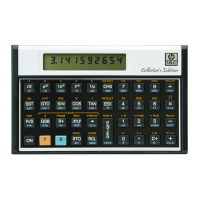Section 12: Calculating with Matrices 161
described in the preceding section. You don’t need to activate Complex
mode for calculations with complex matrices.
Instead, calculations with complex matrices are performed by using real
matrices derived from the original complex matrices—in a manner to be
described below—and performing certain transformations in addition to
the regular matrix operations. These transformations are performed by
four calculator functions. This section will describe how to do these
calculations. (There are more examples of calculations with complex
matrices in the HP 15c Advanced Functions Handbook.)
Storing the Elements of a Complex Matrix
Consider an m × n complex matrix Z = X + i Y, where X and Y are real
m × n matrices. This matrix can be represented in the calculator as a
2m × n “partitioned” matrix:
Z
P
=
X
Y
The superscript P signifies that the complex matrix is represented by a
partitioned matrix.
All of the elements of Z
P
are real numbers—those in the upper half
represent the elements of the real part (matrix X), those in the lower half
represent the elements of the imaginary part (matrix Y). The elements of
Z
P
are stored in one of the five matrices (A, for example) in the usual
manner, as described earlier in this section.
For example, if Z = X + iY, where
X =
x
11
x
12
x
21
x
22
and Y =
y
11
y
12
y
21
y
22
,
Real Part
Imaginary Part

